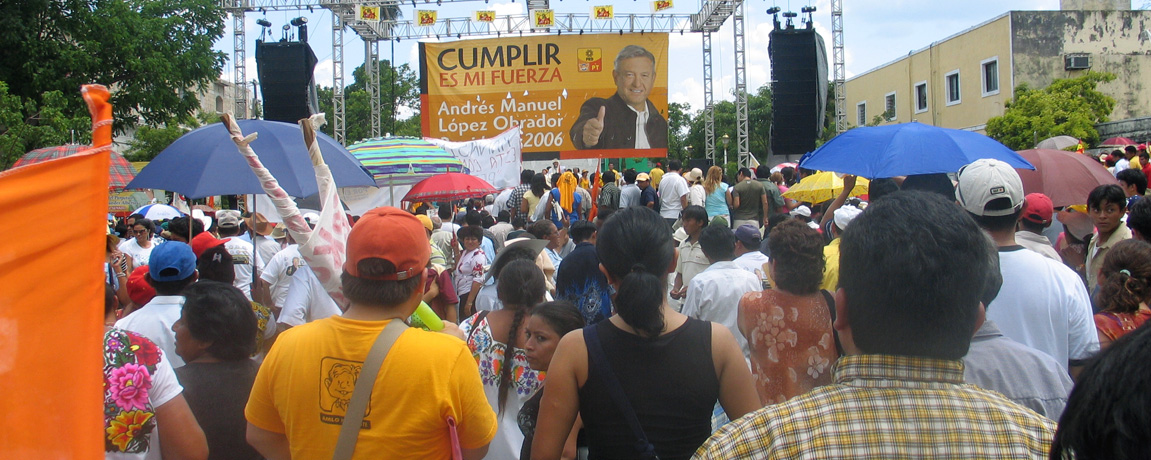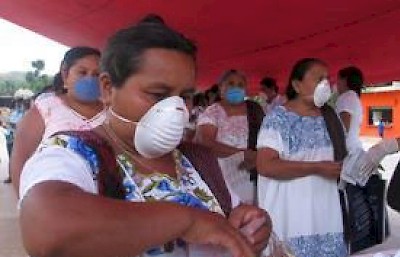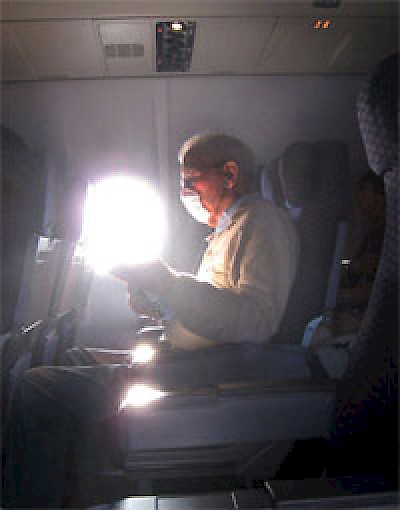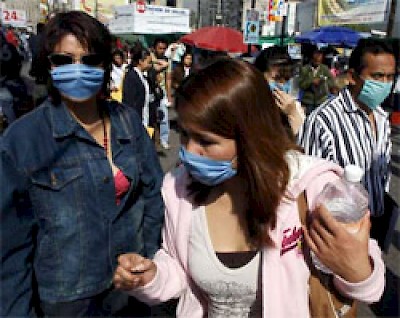Yucatan News: Flu Updates
>
News starting May 04, 2009
One Case of H1N1 Influenza Confirmed in Yucatan
An 8 year old boy, from the interior of the state, is in the hospital in Merida with the only confirmed case of H1N1 in the State of Yucatan. In another case, a person who was ill came into the state from Quintana Roo. He was taken to the hospital in Valladolid and his tests were sent off to Mexico City as well. They have come back negative, so the little 8 year old boy from the interior of the state is still our only case of H1N1 Influenza. FYI: Yucatan does not have a backlog of sick people whose tests have not come back. These were the only two individuals in the state who showed any type of resporatory illness. In addition, there has also been one case of H1N1 confirmed in Quintana Roo.
Update: H1N1 Declining in Mexico
Throughout the past week, news reports concerning the H1N1 Influenza virus have dominated all forms of news reporting. As the confirmed number of cases of H1N1 Influenza continues to change, we suggest that our readers use only the following official resources to monitor this situation.
CDC's H1N1 Page
(has state-by-state chart with numbers of cases and deaths)
On this page, you will learn that there are 200,000 cases of influenza in the U.S. each year and that 36,000 of those cases end in death.
Here's a link to a New York Times article by the former Minister of Health in Mexico, who is now Dean of the Harvard School of Public Health.
On this page, you will learn that the World Health Organization believes that it needs to use this kind of fear-inducing terminology (global pandemic) in order to get ahead of any new influenza outbreak because influenza does have the potential to kill large numbers of people. We cannot help but wonder if triggering a new phase of worldwide panic and economic disaster is really necessary in an effort to accomplish their goal.
Secretaria de Salud H1N1 Page
(click on Statistics for Confirmed Cases of H1N1 for state-by-state map and chart with numbers of cases and deaths)
Mexico's cases of H1N1 Influenza seem to have been confined mostly to Baja California and a semi-circle in the interior of the country. The Baja cases should probably have been counted along with the cases in California, U.S. The semi-circle in the interior of Mexico includes (north to south): San Luis Potosi, Hidalgo, Estado de Mexico, D.F. (with by far the most cases) and Tlaxcala.
Finally, the flu craziness is dying down, in Mexico anyway. Here's what the WHO had to say about Mexico's response to the swine flu.
International Travel: No borders or airports have been closed or recommended for closure.
All Entrances and Exits Now Being Monitored for H1N1
There are a total of 12 entrances into the State of Yucatan, by land, sea and air. At the present time, all are being monitored so that no one who is ill will be allowed either in or out of the state without receiving proper medical attention and testing for H1N1. Working Gringa traveled this weekend to Michigan, and reports that she was handed a questionnaire upon leaving and upon returning. The questionnaire was identical each time, and asked her to check boxes if she had shown any of nine symptoms. She had to record her name, address and phone. And on returning, she was also “beamed” with some sort of device which apparently monitored her temperature. About ten people on the plane leaving Merida were wearing facemasks, and only one person was wearing one on the way from Houston to Merida. All the workers in the Merida airport were wearing facemasks, and some of them were wearing gloves too. No workers in the Houston or Detroit airports were wearing gloves or masks.
Everything Is Closed Except Essential Services
Throughout Mexico, the only activities of work that are being carried out are in sectors related to communication, transportation, medical care and pharmacies, and food. Everything else is closed until at least the morning of May 6. If that changes, there will be an announcement by the President of Mexico and by the State of Yucatan.
Warning to Individuals Who Promote Events
For those who think that they can defy the ban on events at which large groups of people will be thrown together and put at risk for developing H1N1, the State of Yucatan has a little something for them... a prison sentence of one to six years and a fine of between 50 and 200 minimum wages. Word has come down that the government will be completely insensitive to anyone who puts the health of Yucatecos at risk until further notice.
National Olympics Postponed
After many of the states, including Yucatan, sent word that they would be keeping their young Olympic contenders at home this year, the National Olympic Games for 2009 in Mexico have been postponed until further notice. This does not mean that our athletes have stopped training. They are young, strong, and healthy; and say that there is no way they are going to lose all that they have trained for just because of a little setback. So they continue to train and will be ready to compete here at home and around the world as soon as it is safe to do so.
Looking Ahead to Dia de la Marina
June 1 is la Dia de la Marina, and they don't do it any better anywhere than in Progreso! Look for an entire month of non-stop fun to be had on the beach and in the water. At the beginning, there will be the annual "oar and boating" races, followed by the crowning of the Queen. Last year, there was a wonderful outdoor dinner/dance. It was a dress-up affair, complete with the officials of the Armada in attendance. Then, wonderful performances by professional bands and orchestras all month long. Later in the month will come the Volleyball Tournaments on the beach, along with the "Mr. Marino" competition (lots of muscles here!). Finally, at the end of June, there will be the annual cycling marathon. No dates have yet been posted but, as soon as we get H1N1 behind us, look for new dates and plenty of fun to help everyone start off the summer with a bang.












Comments
Brenda Thornton 16 years ago
My heart goes out to Mexico and its' people. This flu outbreak has been a great burden for them and it has cost them much in illness, income, and in their feeling of security. I do feel, however, that their government mishandled the situation at the beginning andthe subsequent events were more dramatic because of it.
In this day of international travel, where one can circle the glove in 24 hours, it is imperative that governments and countries respond to uncertain, different things quickly and effectively. China hid SARS, even though they were fully aware of its' mortality rate, and did not tell the world intentionally, which for me as a medical professional, is a criminal act. Mexico just failed to recognize the implications quickly enough and lacked the public health infrastructure to act on it properly. That doesn't get them fully off the hook, as Mexico is not a poor country by standards in many parts of the world, it just has a situation where too much of the GNP goes to too few and the government fails to take enough of it to adequately set up health infrastructure with it. The US is becoming the same way.
However, this was a type of virus which held the potential for a real, honest to goodness pandemic of epic proportions because of the way in which modern travel has opened us up to worldwide transmission quickly. This virus could still mutate very quickly and become a huge killer. Hopefully, they will have a vaccine for it by the fall, when the transmission should pick up, and it will not have mutated in the interim. That should tamp it down greatly.
The flu does kill many around the world every year, but it primarily kills those who are weak, as in the very young who haven't fully developed immune systems and the very old. That doesn't mean that it is insignificant, because it is. This one seemed, at first, to be hitting those with the best immune systems hardest. Additionally, we must remember that the 1918 pandemic did the same thing, because the type of flu involved was a new kind of flu, the immune systems of the young and healthy over-responded to it because of that, causing greater damage to the mucosa in the respiratory sytem and set the sufferers up for death due to viral and secondary bacterial pneumonia deaths. This flu is a new flu, or a new type which means that no one has a significant immune response to recognize it and not over react, as was the 1918 flu.
I wish the best to Mexico and the world on this. The WHO responded mostly in the correct way, and when things such as this hit, we cannot wait days in order to respond in this day of globalization. Days could mean the difference between a relatively small number of casualties, and perhaps hundreds of millions, or even a billion people.
Reply
CasiYucateco 16 years ago
Yes, there has been a huge disruption, but it is not misplaced.
The appearance of H1N1 represented a new type of influenza against which humans have no pre-existing immunity. If the avian/swine/human strain had proven to be virulent and deadly, there would have been a massive disaster.
Exactly the measures that were taken by closing schools and events prevented H1N1 from becoming a huge problem. These are standard disease outbreak procedures utilized because they are scientifically known to work. Public health authorities are working hard to protect our own lives. "Everyone stay home" does work. It makes the flu "disappear." Since new infections are very limited, the spread dies out.
Lastly, there is a difference between seasonal flu and pandemic flu. While too lengthy to describe in a comment, the main differences are the infection rate and the fatality rate. Changes of a small percent in either direction makes a huge difference.
In 1918, the "three day fever" appeared in the Spring to mild effect. Everyone thought it was gone. In the Fall, it reappeared with a vengeance. Over 50 million people worldwide died. In the USA, authorities were concerned that society itself would cease to function. In some areas, people starved to death because family and friends deserted them at the first sign of the deadly flu.
And that was before air travel and the population densities we have today. It's better to be careful, than fail to heed warnings.
Reply
Roddrigo 16 years ago
I completely agree! This FLU BOGUS SCARE has some Serious ramifications re: WHO
They created this just to get our attention? Why are they NOT doing anything about the 3000+ AMERICANS Who DIE every month from "Ordiinary" Flu/Gripe? What ??? gives them the right to disrupt the 2nd Largest $$$ Generator for Mexico....TOURISM! Not only have we had to Battle the Double Whammy of a Declining World Economy & Drug Related Violence Scares NOW THIS!
We on Isla Holbox are getting ready to kick-off our "SWIM With Whale Shark" Season May 15th & now we're getting Sporadic Cancellations from Americans Worried for their Lives? SUCH HOG-WASH! Somebody is online to make BIG $$$$$$ From this nonsense. Next we'll be told YES we found the Cure Get your $$$$ VACCINE Shot now so "IF" it comes back, you'll be protected............YEA RIGHT! As they say in Brooklyn Forgetaboutit!! Thank God this did not hit in the Middle of Summer Tourist Season.
The WHALE SHARKS are immune They Cannot GET or RE-Transmit the FLU! Come to Isla Holbox where we've had NOT ONE Case of this Bogus Illness!
What Next? YES 2012 is coming Time for a MAJOR CLEANSING" !!!!!!!!!!!!!!!!!!
Reply
Janine 16 years ago
Great short and sweet paragraph about what the WHO has done to escalate fears, not to mention propagating an unnecessary backlash against Mexico, even if unintended. I have friends all over Mexico who are just fine, a few feeling temporarily confined to home and work, but all are well. Let's hope this subsides soon and Mexican tourism gets back on it's feet a.s.a.p. I wish all at Yucatan Living, your loved ones and all in the beautiful country of Mexico health and prosperity y les mando mil abrazos!
Reply
YucaGringo 16 years ago
On this page, you will learn that there are 200,000 cases of influenza in the U.S. each year and that 36,000 of those cases end in death.
The CDC page actually says that 5% to 20% of the population get the flu and 200,000 are hospitalized each year.
Reply
(0 to 5 comments)